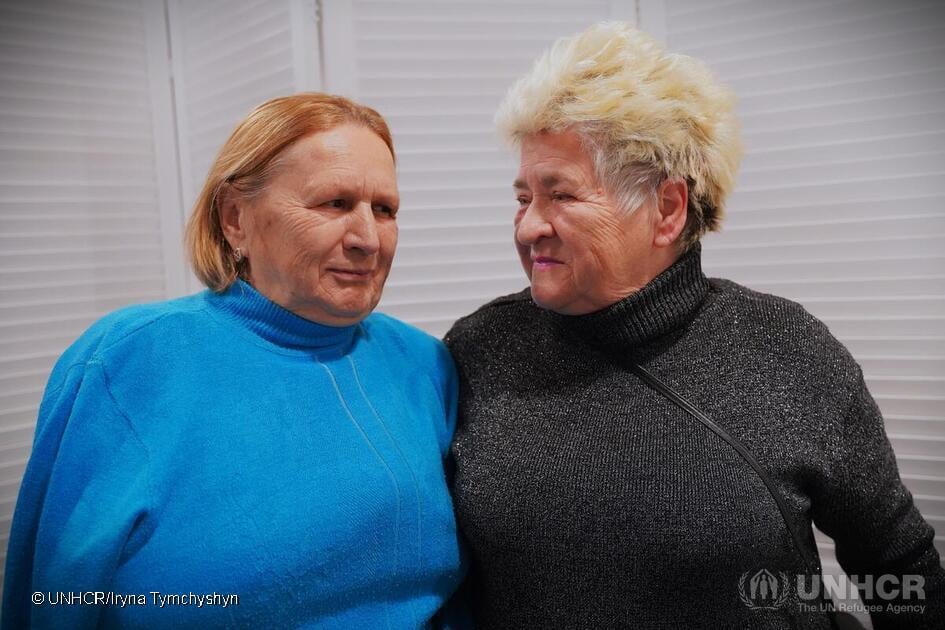By Konstantin Fastovets, UNHCR Economist for Europe

Effective social protection systems are essential in times of crisis, offering stability and support, especially to vulnerable populations. For Ukraine, a country affected by conflict and displacement, improving social protection systems is not just essential—it is urgent.
A new interagency Access Study, developed in partnership with Ukraine’s Ministry of Social Policy (MoSP), fills in some of the evidence gaps regarding the current state of Ukraine’s social protection programmes.
Using survey data and responses from interviews and focus group discussions, it examines the effective coverage of Ukraine’s largest social protection programmes managed by the MoSP.
Several critical findings emerge (also discussed at a recent event that can be viewed here):
1. Effective coverage of social assistance1 is uneven across programmes and low overall
There are significant disparities in the effective coverage of Ukraine’s largest social protection programmes, which include the State Social Assistance for Low-Income Families (GMI), Housing and Utilities Subsidy (HUS), Allowance for Internally Displaced Persons (IDP), and disability support programmes. Together, these represent roughly three quarters of the central government’s social assistance budget.
While the IDP Allowance and disability benefits coverage rates were found to stand at 81% and 70%, respectively, HUS and GMI demonstrated much lower figures of just 35% and 28%. Weighting these by programme size yields an effective coverage estimate for social assistance overall of 50%.
Figure 1: Effective coverage in the general population by programme

Although the above results are indicative, they carry important implications for the Ministry of Social Policy (MoSP) as well as humanitarian and development actors. For one, they suggest that the potential social assistance caseload may be much larger than what is currently captured by the system. This indicates that many eligible individuals and households remain underserved, emphasizing the need for targeted strategies to address these gaps. Second, they imply that access challenges need to be individually understood on a per-programme basis.
2. IDPs face more severe barriers to access
Coverage rates for IDPs in key programmes like the GMI were found to be lower compared to the general population (17% versus 30%). The study identified that a lack of awareness and misinformation about eligibility criteria, which are also important hurdles for the general population, were present to an even greater degree in cases of displacement.
Table 1: Effective coverage by social protection programme and population stratum (IDP vs non-IDP)

3. Recipients of humanitarian aid benefit from better coverage
In contrast to IDPs, recent recipients of humanitarian aid were found to experience higher effective coverage of state programmes compared to the general population. This success is likely a result of humanitarian organizations complementing aid provision with counselling on the state protection system and assistance in navigating application processes.
4. Digital application is associated with higher coverage
The Access Study highlights the potential of digital tools to enhance coverage of social protection programmes. Households that utilized digital application platforms demonstrated higher rates of access compared to those that did not.
5. Information, infrastructure, and bureaucracy are key barriers
The survey identified lack of information as the most prevalent barrier, with 20% to 49% of eligible households either unaware of programmes or misinformed about eligibility criteria. Interviews and focus groups also highlighted infrastructure challenges, such as limited accessibility for people with disabilities and the need to travel long distances, as well as bureaucratic hurdles, including overly complex application processes.
Recommendations to bridge identified access gaps
The Access Study offers several recommendations for the Ukrainian government, development actors, and the humanitarian community:
1. Improve outreach to raise awareness. As lack of information about the existence of programmes and eligibility for them was identified to be a widespread issue, this barrier may yield the most tangible results if addressed. Focus group participants suggested making more use of preferred communication channels by households, which, depending on the region could be telephone lines, mobile text messages, social media platforms, or community boards. Other initiatives could include simplifying the legalistic language of official communication, creating an easy-to-use centralized online resource, etc.
2. Address logistical challenges and simplify application procedures. While these barriers were less frequently reported when compared to lack of information, they are likely to become more prominent as awareness increases. Programmes with higher effective coverage, such as disability support, are already demonstrating the prevalence of these.
3. Increase the use of digital application methods. Even though the use of digital application platforms is associated with higher effective coverage, the study found that only 20% of respondent household in the general population are utilizing these tools. Uptake could be increased by improving digital literacy, especially in the case of the older population, and streamlining ease of use.
4. Focus on the internally displaced. With some 3.6 internally million displaced individuals since the beginning of the war, Ukraine has an enormous IDP population. As survey data demonstrates that access challenges for this group are worse than for the country overall, a special focus needs to be dedicated to removing barriers, especially in the case of means-tested programmes.
5. For humanitarian agencies: continue supporting access to state programmes. Given these efforts seem to be yielding results, humanitarian agencies should continue providing information and application support to their caseload. This intervention can remain meaningful even as cash assistance eventually winds down.
A recent presentation and discussion of the study can be viewed here.
[1] Includes all non-contributory social protection programmes
